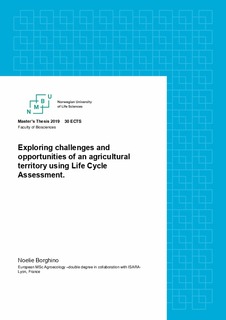| dc.contributor.advisor | Godinot, Olivier | |
| dc.contributor.advisor | Breland, Tor Arvid | |
| dc.contributor.advisor | Moraine, Marc | |
| dc.contributor.author | Borghino, Noélie | |
| dc.date.accessioned | 2019-11-20T14:39:06Z | |
| dc.date.available | 2019-11-20T14:39:06Z | |
| dc.date.issued | 2019 | |
| dc.identifier.uri | http://hdl.handle.net/11250/2629579 | |
| dc.description.abstract | Biomass of agricultural origin (BAO) has many uses and results from human activities in a specific context. Its management should consider the associated environmental impacts. Life Cycle Assessment (LCA) is a standardized environmental impacts evaluation method. Recent studies have emphasised its relevance at territory scale, as it generally corresponds to the scales of impacts and impact management. In this context, this study performed territorial LCA on North Aube agricultural territory. LCA was performed on main production sectors, from inputs production to first processing industry gate. Production’s impacts were expressed per ha, per kg and in proportion of impact carried by each product relatively to the total territory’s impact. Results show the major contribution of grain and cash crops (82-95% of each impact category), mainly due to on-farm emissions and mineral fertilizer use. To a smaller extent, pig and broiler production carry a part of the territory’s impact. Results emphasized that processing should not be neglected. Two scenarios considering biomass use change were designed and assessed in order to validate territorial LCA as a relevant tool for prospective approaches. To improve the applicability of the method with regards to scenarios assessment, consequential LCA should be performed. In addition, further studies should use complementary indicators. | nb_NO |
| dc.language.iso | eng | nb_NO |
| dc.publisher | Norwegian University of Life Sciences, Ås | nb_NO |
| dc.rights | Attribution-NonCommercial-NoDerivatives 4.0 Internasjonal | * |
| dc.rights.uri | http://creativecommons.org/licenses/by-nc-nd/4.0/deed.no | * |
| dc.subject | LCA | nb_NO |
| dc.subject | Agricultural biomass | nb_NO |
| dc.title | Exploring challenges and opportunities of an agricultural territory using Life Cycle Assessment | nb_NO |
| dc.type | Master thesis | nb_NO |
| dc.description.version | submittedVersion | nb_NO |
| dc.source.pagenumber | 39 | nb_NO |
| dc.description.localcode | M-AE | nb_NO |

